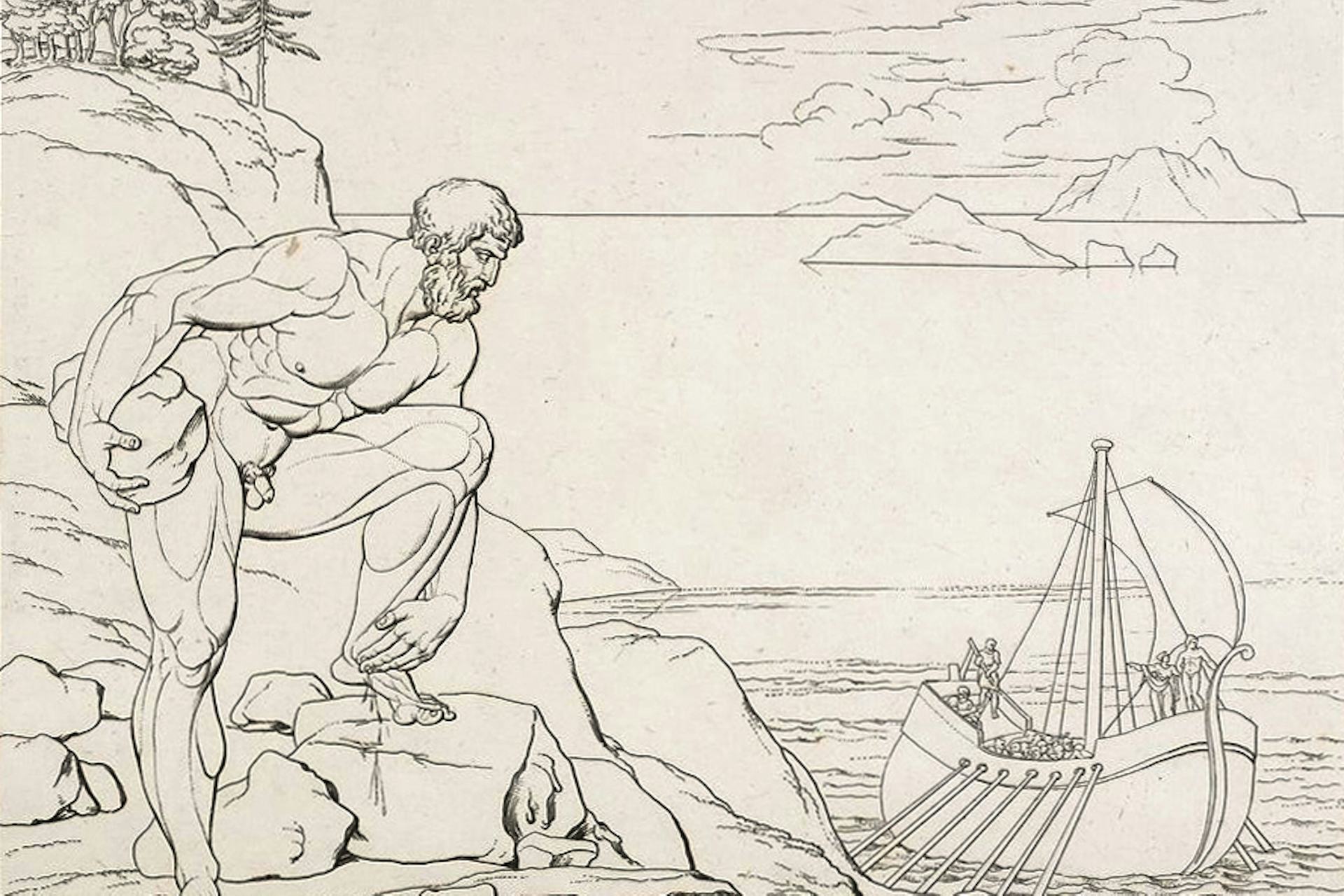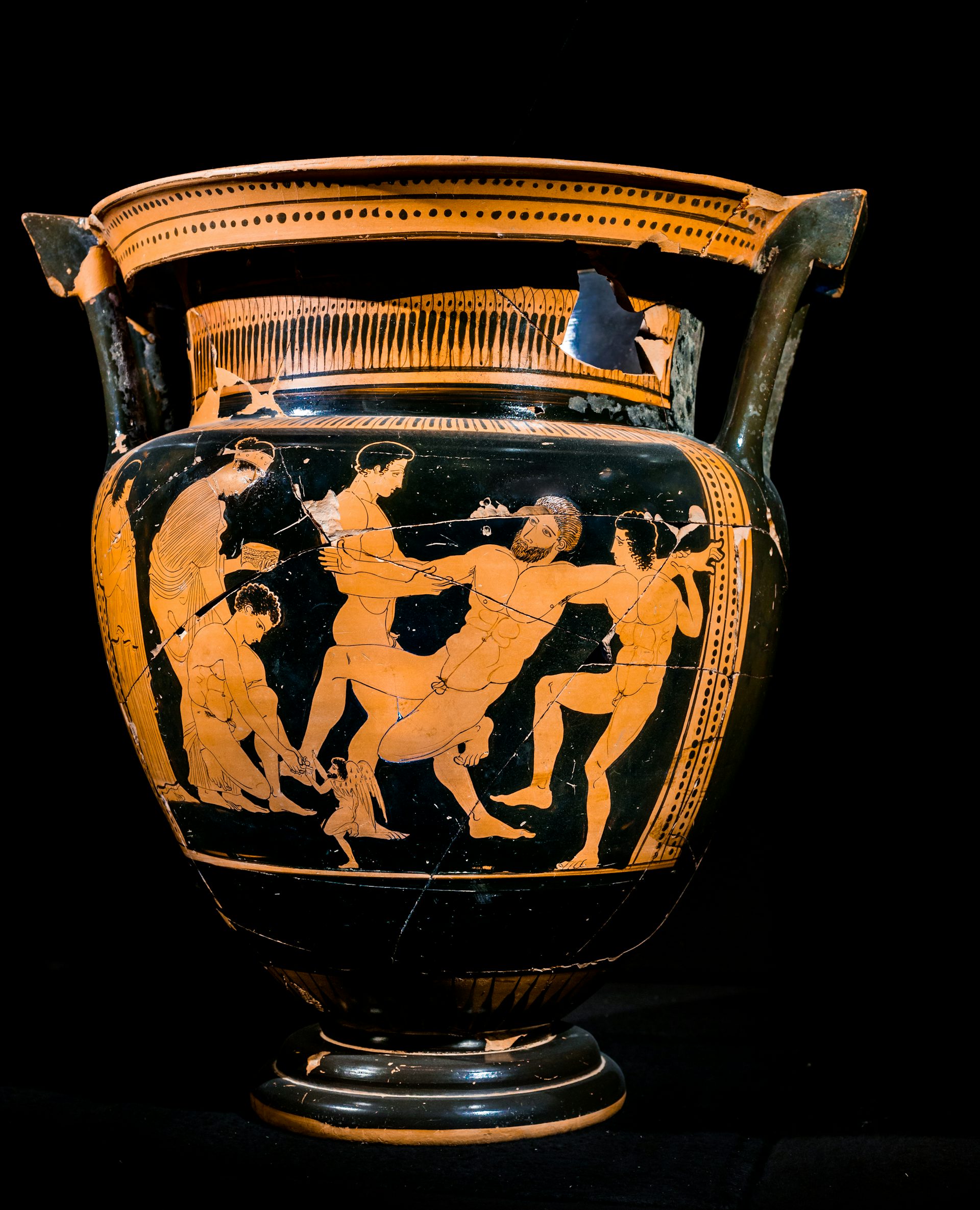Talos

Talos (Plate 23) from The Argonauts according to Pindar, Orpheus, and Apollonius of Rhodes, in Twenty-Four Plates by Asmus Jacques Carstens and Joseph Koch (1799)
Bibliothèque nationale de FrancePublic DomainOverview
Talos was the giant bronze guardian of Crete. He was a kind of automaton who, in the standard tradition, had been fashioned by the smith god Hephaestus. Talos patrolled Crete every day, driving strangers away by throwing huge stones at them or burning them alive. But when the Argonauts encountered Talos during their journey home, the witch Medea destroyed the creature by enchanting him and causing him to graze the vein that held all his vital fluid. He then “bled” to death.
Etymology
The etymology of the name “Talos” (Greek Τάλως, translit. Tálōs; also spelled Τάλος/Tálos or Τάλων/Tálōn) is unclear.
One ancient source claimed it was the Cretan word for “sun” (presumably connected to the word ἅλως/hálōs, more familiar in the form ἥλιος/hḗlios).[1] Another source interpreted Talos as a bull, perhaps suggesting an etymological connection with the Greek word ταῦρος (taûros), meaning “bull.”[2] The name may also be related to the verb ταλάσσαι (talássai) or τλῆναι (tlênai), meaning “to endure, suffer.”
A more current etymology has identified a link between the name Talos and the Greek word χαλκός (chalkós), meaning “bronze”—a logical conclusion given that Talos was made of bronze. This etymology also suggests that the Greek Talos may be identical to the Etruscan Chaluchasu, a brazen figure who features in Etruscan art.[3]
Pronunciation
English
Greek
Talos Τάλως (translit. Tálōs), Τάλος (translit. Tálos), Τάλων (translit. Tálōn) Phonetic
IPA
[TEY-los] /ˈteɪ lɒs/
Attributes
General
There were conflicting accounts of Talos’ nature in antiquity. In the best-known tradition, he was a bronze man—a kind of automaton or robot—fashioned by the smith god Hephaestus. But in one account, he was instead the last survivor of the Bronze Age, one of the mortals who lived before human beings were created. In another, he was a bull rather than a man.[4] One source referred to Talos with the strange term χάλκειος τριγίγας (chálkeios trigígas), meaning “bronze triple-giant.”[5]
Talos was the guardian of Crete, a large and important island in the Aegean Sea. His vital fluid—usually described as “ichor” rather than blood—flowed through a single vein running from his neck to his ankle, where it was fastened by either a nail[6] or a thin layer of skin.[7] Aside from this one (admittedly significant) weakness, Talos was extremely strong and fearsome.
It was said that Talos circled Crete three times a day on his untiring feet, ever on the lookout for dangerous strangers.[8] When he did encounter strangers or attackers, he would drive them away by throwing giant boulders at them—his preferred form of combat. In some accounts, though, Talos could also make himself very hot (presumably by heating himself in a fire) and then burn his enemies to death by embracing them.[9]
Iconography
Talos was particularly popular on the coinage of Phaestos, an important city in central Crete. Rather uniquely, these Talos coins show the bronze guardian with wings. On some of them, he also has a dog as a companion.

Obverse of a silver didrachm coin from Phaestos in Crete showing Talos (the inscription on the bottom reads “Talon”) (ca. 300/280–270 BCE). Cabinet des Médailles, Paris, France.
JastrowPublic DomainIn ancient art, the most popular scene from Talos’ myth was his confrontation with the Argonauts (and subsequent death). Talos himself was usually depicted as a large and powerful man of bronze; often, great care was taken to highlight his single throbbing vein and the nail rammed into his ankle, holding in his vital fluid.[10]
Family
Family Tree
Parents
Fathers
Mother
- Oenopion
- Cres
- Meliae
Siblings
Brothers
- Athamas
- Euanthes (son of Oenopion)
- Melas (son of Oenopion)
- Salagus (son of Oenopion)
Children
Sons
- Phaestus
- Leucus
Mythology
Origins
The origins of the Talos myth are mysterious. The ancient Greek philosopher Plato rationalized the myth, saying that the bronze robot who ran around Crete three times a day was inspired by Minos’ practice of parading his code of law (which he had inscribed on bronze tablets) around his island kingdom three times a year.[15] A more contemporary explanation for the myth is that it reflected the lost-wax method of casting bronze.[16] Talos may have also originated from an old Cretan god who was eventually equated with Zeus under the title “Zeus Tallaios.”[17]
Talos’ origins within myth are equally obscure. In the standard account, he was a bronze man fashioned by Hephaestus. He was then either given by Zeus to the god’s mortal lover Europa as a bodyguard,[18] or was given by Hephaestus to Minos, Europa’s son.[19] But other traditions made Talos one of the men of the Age of Bronze, while others seem to have envisioned him more or less as an ordinary man with human lineage (see above).
In one strange account, Talos originally lived on the island of Sardinia, to the west of Italy. There he would kill people, causing them to open their mouths in a kind of grin as they died (the origin, apparently, of the term “sardonic grin”). Later, when Talos came to Crete and the Sardinians attempted to follow him, Talos killed the Sardinians by leaping into a fire, heating himself to a scorching temperature, and then clutching them to his chest.
Talos and the Argonauts
Talos is known almost exclusively in connection with the myth of the Argonauts. The Argonauts had sailed with the hero Jason to steal the Golden Fleece from the remote kingdom of Iolcus. On their return journey, they passed by the island of Crete and encountered the gigantic and unwelcoming Talos:
And Talos, the man of bronze, as he broke off rocks from the hard cliff, stayed them from fastening hawsers to the shore, when they came to the roadstead of Dicte’s haven… So the heroes, though outworn with toil, quickly backed their ship from the land in sore dismay.[20]
Talos pummeled the tired Argonauts with stones, preventing them from landing on Crete for supplies and refreshments. Though they were ultimately able to defeat the bronze guardian, there are several different versions of how they did so. In most (though not all) accounts, it was Medea, the Colchian witch who accompanied the Argonauts back to Greece after helping them steal the Golden Fleece, who brought about Talos’ doom:
In one version of the myth, Medea uttered spells from the ship that caused Talos to stumble and graze his ankle on a sharp rock. The rock split Talos’ vein so that his divine blood (“ichor”) spilled out, killing him.[21]
In another version, Medea gave Talos drugs that caused him to go mad.[22]
In another version, which must have required the Argonauts to get quite close to Talos, Medea promised Talos that she would make him immortal. But once she was next to him, she pulled out the nail that sealed his vein at his ankle and he “bled” to death.[23]
In one version, known from representations in ancient art, Medea seems to have dazed Talos with her spells so as to give the heroes from the Argo a chance to overpower him.[24]

An Attic red-figure column-krater (ca. 450–400 BCE) depicting the death of Talos. Talos is shown overpowered by two young Argonauts (probably the Dioscuri) while another Argonaut (perhaps Jason) pulls the nail from his ankle, assisted by a small winged figure representing Thanatos (Death); a young woman (probably Medea) observes the scene (left). National Archaeological Museum of the Caudini Samnites, Montesarchio, Italy.
ArchaiOptixCC BY-SA 4.05. A final version cut Medea out entirely and instead had the Argonaut Poeas shoot Talos in the ankle with an arrow.[25]
Pop Culture
Today, Talos is still best known in connection with the tale of the Argonauts. He makes an appearance in the 1963 film Jason and the Argonauts, in which Jason (rather than Medea) destroys him by unscrewing the cap holding in his steaming “blood.” Talos, in various guises, has also appeared in other contemporary adaptations of Greek mythology, including Rick Riordan’s The Titan’s Curse, the third novel of the Percy Jackson and the Olympians series.